Furniture makers answer many hospital challenges
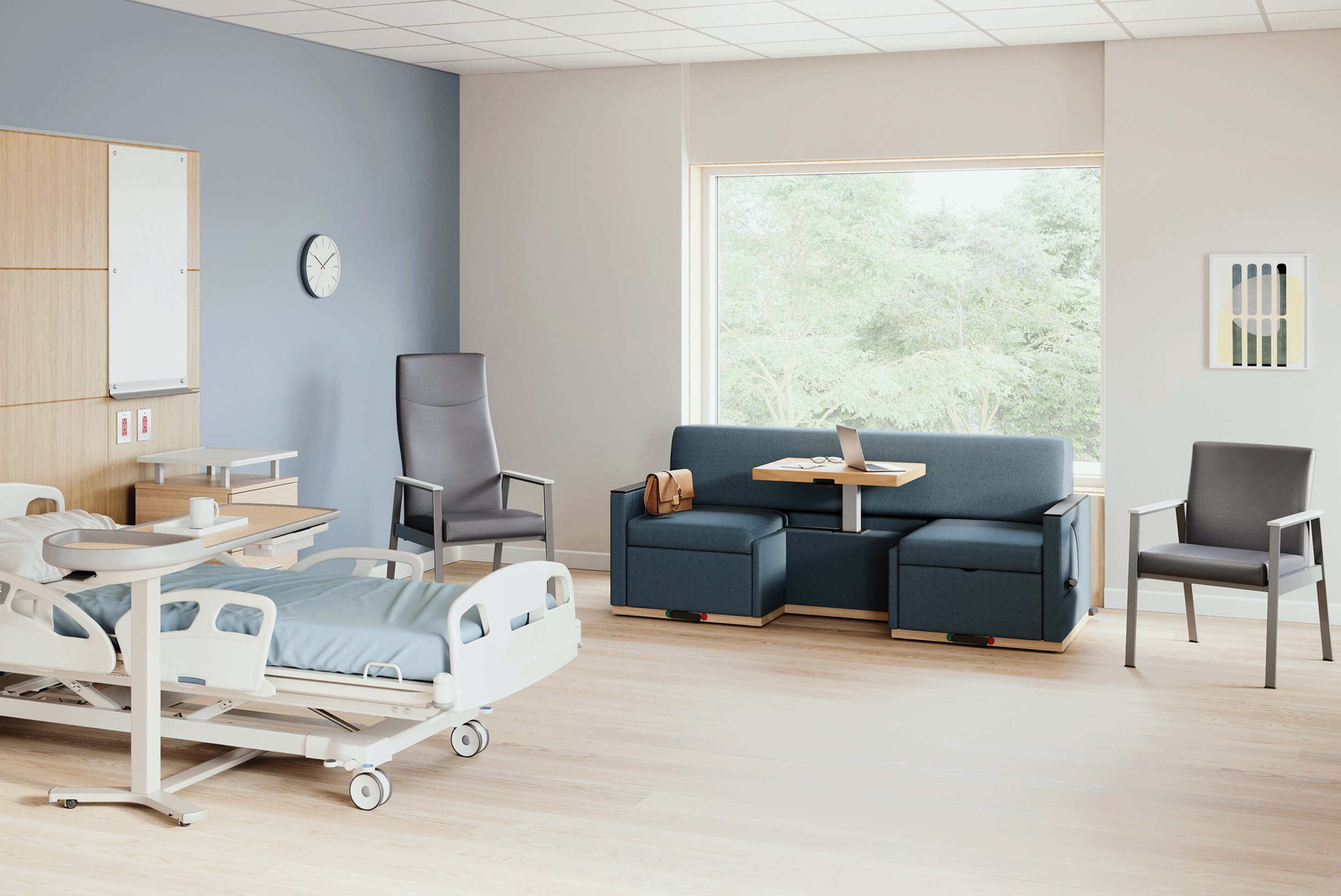
Image courtesy of MillerKnoll
The latest health care furnishings boast a range of features to handle the many challenges hospitals and other health care facilities throw at them. These include budgetary restrictions, the need for durable and cleanable surfaces, the ability to accommodate new technologies, and demand for creative designs that enhance the experience of patients, visitors and staff.
For example, hospitals are struggling with financial pressures brought about by the pandemic as well as supply chain and staffing shortage issues, according to Rosalyn Cama, FASID, NCIDQ, EDAC, president at Cama Collection LLC, New Haven, Conn. “Most of our health care clients are seeking multipurpose solutions. One example: recliners that transition patient care from bed to recliner, providing increased mobility. Another is privacy glazing in patient room doors, which replaces cubicle curtains, thus reducing the spread of infection and increasing clinical visibility.”
The importance of cleanability has increased as hospitals navigate a post-pandemic world. Facilities managers are asking for furnishings that are easy to clean as well as dependable and durable but also adhere to industry standards for public institutions.
In the past, finishes on furnishings that endured constant cleaning and disinfecting were required to meet infection prevention needs, according to Kim Montague, AIA, EDAC, LEED AP, NCARB, executive director for research and insights at Kimball International, Jasper, Ind. “This is still the case. However, health care organizations have put a higher emphasis on it due to the pandemic and the need to prevent the spread of viruses. It was always top of mind for hospitals, but today it’s also a top consideration for furniture specifications in all vertical markets.”
Another trend in hospital furnishings is therapeutic design — the process of designing environments that promote psychological wellness through light, color and other sensory elements, thus creating less stressful spaces. “Therapeutic design improves the psychological well-being of patients, staff and visitors. Noise control, for instance, can reduce stress,” says Pam Krill, director of health care marketing at Steelcase Health, Grand Rapids, Mich.
Also, new communications technologies must be addressed within furniture environments. “Examples such as video conferencing and audiovisual systems need to be fully understood by furniture manufacturers in order for us to design a space that meets every demand, including technology integration,” says Jonathan Webb, workplace market director for KI, Green Bay, Wis.
Recent innovations
Stance Healthcare, Kitchener, Ontario, Canada, has introduced the Clover Lounge Collection, which surrounds patients, visitors and providers with attractive curves. It’s available in one-, two- and three-seat lounge chair size options. A power/USB port is offered on one or both sides of the chair.
“Featuring a sculpted back and open seat that encourages relaxed seating positions, Clover can be used by many people at once, including parents with children or by individuals sharing the lounge chair,” says Carl Kennedy, CEO at Stance.
Stance Healthcare also has introduced the Spry Metal Seating Collection. Featuring solid surface arm caps, Spry offers 360-degree cleanout for infection control and coordinates with linking tables, which creates space between users. The collection comes in three sizes of linking tables and can be configured into a wide range of table and chair combinations. Spry also is available armless for hospitals seeking to minimize touch points.
MillerKnoll, Zeeland, Mich., manufactures the Nemschoff Easton Family of seating and tables, introduced by Herman Miller. It is designed to create a consistent facilitywide aesthetic, from the waiting room to the patient room. The collection stands up to rigorous use and frequent cleaning because of its powder-coated metal construction, Corian surfaces and wide selection of health care textiles. Standard cleanout design, wall-saver legs and non-marring glides make the seating and tables easy to maintain. The collection includes multiple seating, side chair, “plus” chair, patient chair and easy access chair, as well as a side and coffee table.
“Health care spaces designed with Easton promote inclusion by providing a variety of seating configurations that accommodate people’s needs,” says Michelle Ossmann, Ph.D., MSN, AAIA, director of health knowledge and innovation. “Multiple seating lets families stay close together. For example, our plus chair fosters belonging — blending with other seating configurations within the product line while giving extra room to those who need it.”
Sustainability is a key component of the latest hospital furniture products and materials. “Sustainability is at the forefront of our process — from design to delivery, to recycling or repurposing,” Ossmann says. “We help hospitals minimize exposure to harmful chemicals in their facilities by vetting our products for formaldehyde, per- and polyfluoroalkyl substances, polyvinyl chloride, antimicrobials and flame retardants. We maintain a database of 4,000 chemicals that have been eco-profiled.”
Steelcase Health recently expanded its West Elm Health Collection, which includes Slope, Sterling, Mesa and Lucas seating products that add a welcoming aesthetic to hospital areas such as lobbies, reception areas, waiting spaces, physician offices, outpatient centers and virtual care spaces. The seating products hold up to the rigors of health care spaces and feature appropriate recline, metal legs, crumb sweep and health-appropriate, high-performance fabrics.
Steelcase Health also offers ModuForm solutions for behavioral health environments. They are available in a variety of styles — from vinyl that is foam filled, and puncture-, fluid- and ligature-resistant to tailored fabric covered in welcoming upholstery — to promote recovery-oriented, safe and inviting spaces that support socialization.
Furniture manufacturers are using new materials to improve health care outcomes. “Celliant by Designtex is one of the latest materials to help increase blood flow by opening up capillaries, which promotes greater oxygen flow to cells,” says Seth Starner, business development manager at Steelcase Health. “This improves energy and can promote alertness and overall comfort. While sitting on Celliant upholstery, the body is able to increase local circulation, rebuild and recharge.”
More options
Allseating, Mississauga, Ontario, Canada, offers the Rühe collection of public seating. It is comprised of guest, patient, lounge and tandem seating as well as several table options. The collection supports up to 400 pounds on most models and has a durable 14-gauge steel frame that features seven support ladders paired with common arm components that contribute to 15 standard seating configurations. Guest seating allows for the option of a standard seat size, plus or love seat to accommodate a broad range of body types and situations.
“The patient variation has a higher back and can be specified as a standard, rocker and easy-access chair to ensure patients receive optimal comfort,” says Cindy Lawton-Moreby, vice president of sales at Allseating. Lounge options are available in single, double and triple, while tandem seating can be added as double or triple. Two stand-alone tables and coffee table options are available as well as two linking tables that come in 120-degree end or mid-table variations.
Kimball International has introduced the Embra family of seating, which includes free-standing lounge, sleep sofas and modular community seating. “Featuring clean, modern lines and an elevated design aesthetic, Embra allows users to feel welcome, connected and comfortable,” Montague says. “Custom-designed LED lighting, integrated USB power, softened edge surfaces and storage are featured.” Embra’s construction leverages a structural rail base, balanced on cast aluminum legs that can be added on to create modular configurations.”
Kimball International also offers furnishings designed with behavioral health and well-being in mind, which can be utilized in lower-acuity environments. “Our most recent advances with Tyba and Pairings Perch demonstrate that behavioral health furnishings can be aesthetically pleasing and functional,” Montague says.
Hospital waiting rooms and medical office receptions are moving away from tightly compacted rows of seating, according to Sylvia Nash, vice president of health care at Kwalu, Atlanta. She notes that Kwalu is responding by manufacturing furniture that can be thoughtfully placed, allowing patients and visitors to be comfortable in waiting spaces.
“Small seating groups, anchored by comfortable lounge seating such as Kwalu’s Modena Lounge Collection, allow visitors to wait and work privately,” Nash says. “Modena’s angled, cushioned seats on the lounge chair, love seat and sofa provide support for calves and knees. Closed arm panels also are available. Each piece of the collection is fully health care-cleanable when combined with high-end vinyl fabrics.”
Cama Collection LLC offers the IOA Patient Care Chair, which is designed to increase patient mobility and transform care delivery from bedside to seated care. “It continuously improves with user feedback about versatility in patient population needs and joins a full complement of our company’s seating that meets patient needs during hospitalization and ambulatory care,” Rosalyn Cama says. “We are beginning to test the market for assisted living and at-home care.”
KI has introduced the WiggleRoom Super Structure, free-standing rooms between 6-by-6 feet and 10-by-10 feet that can be created on demand. It comes with three ceiling options (full, louvered and open) so users can control the amount of acoustic privacy they need. Wall materials can be any combination of glass and solid materials for control of privacy or day lighting. “These structures do not attach to any wall or ceiling, making planning in existing spaces easy,” Webb says.
KI also has introduced the Signia task chair, which features a fully ergonomic design. “It’s ideal for long-term sitting due to ergonomic options and a plush memory foam seat cushion that supports individual posture,” Webb says. “Signia comes in either a mesh or fully upholstered back. Back tension and recline settings fit any posture requirement.”
On the cabinetry side, Midmark Synthesis wall-hung cabinetry improves ergonomic reach and visibility while helping enhance storage efficiency and infection prevention. The cabinetry incorporates ergonomic principles and is designed for caregivers who interact with cabinetry in the medical space on a daily basis. It features base and tall cabinets that better position the most-used areas of storage for easier reach by physicians and staff.
“The lowered upper height and thinner depth of the cabinets improve access to storage with less reach and lean required,” says Tracy Timmerman, senior marketing manager at Midmark, Dayton, Ohio. “The use of gravity-fed, angled flow shelving improves visibility and access to supplies, even for items stored toward the back of the cabinet. The cabinetry frees floor space, allowing for better wall-to-wall cleaning and disinfection in high-traffic areas and treatment spaces.”
Some facilities managers may not be fully aware of all the safety and ergonomic issues involved, Timmerman says. “According to the Bureau of Labor Statistics, 76% of health care workers are female, and the average height of females in the U.S. is 5-foot, 4-inches. The typical equipment found in physician practices, clinics and surgery centers is rarely designed for this height. As a result, employees may resort to using stools to reach supplies on upper shelves.”
Coming next
Furniture manufacturers foresee a continued focus on behavioral health as well as more technology to create smart hospital spaces. Also, they see a focus on furnishings for aging populations that create welcoming environments without sacrificing access and safety needs.
“Given that we are seeing a greater awareness for moving to a ‘Quintuple Aim’ for health care improvement, we expect to see more emphasis on solutions that support health care equity,” Timmerman says. “This includes enhanced accessibility in exam rooms.”
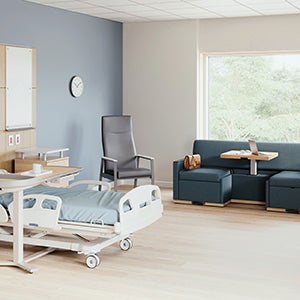
DEPENDABLE DESIGN
The Easton Family of seating and tables is designed to create a consistent facilitywide aesthetic, from waiting room to patient room. MillerKnoll
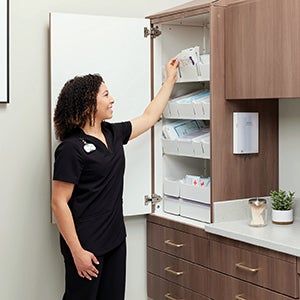
EASY REACH
Synthesis wall-hung cabinetry improves ergonomic reach and visibility, and reduces the risk of stress and strain injuries. Midmark
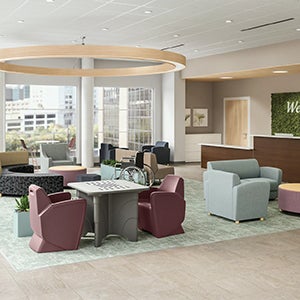
STIGMA-FREE
Available in a variety of styles, ModuForm furnishing solutions are designed to humanize behavioral health experiences. Steelcase Health
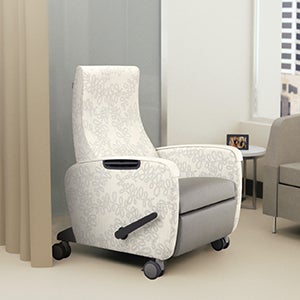
TO YOUR HEALTH
The IOA Cama patient chair is designed to promote healing through increased patient mobility and delivery of nursing care. Cama Collection LLC

WIDE SELECTION
The Embra family of seating includes a free-standing lounge, sleep sofas and modular community seating. Kimball International
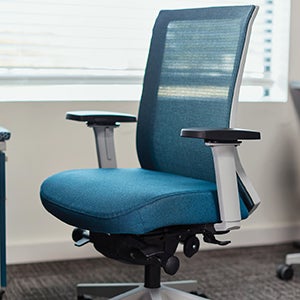
SAFE AND SOFT
Signia task chairs offer a fully ergonomic design and plush memory foam seat cushion. KI
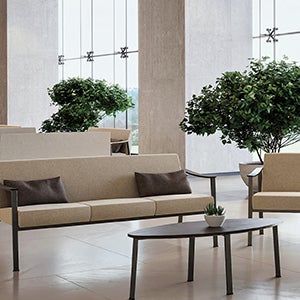
SPECIAL SUPPORT
The Rühe seating collection supports up to 400 pounds and has a durable 14–gauge steel frame. Allseating
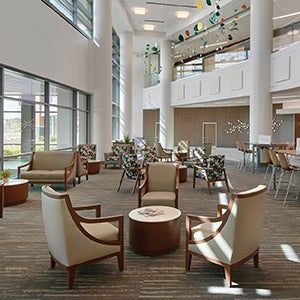
COMFORT FIRST
These chairs and tables provide patients and visitors with comfortable and spacious waiting areas. Kwalu
Neal Lorenzi is a Mundelein, Ill.-based contributor to Health Facilities Management.





